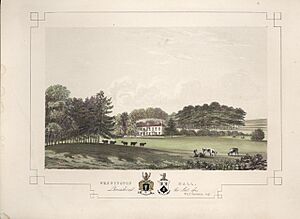Edward Twycross facts for kids
Edward Twycross (born 1803, died 1852) was a talented man from Dublin, Ireland. He worked as a silversmith, a lawyer (called a solicitor), and an author. In 1847, he published a very important book called "The Mansions of England and Wales." This book is still used today to learn about the history of grand homes in England and to trace the family trees of important British families.
Contents
Life
Early Years
Edward Twycross was born in Dublin, Ireland. He was the third son of John Twycross, who was a goldsmith and jeweler in Dublin, and his mother, Sarah Clarke.
His Career
Edward started studying at Trinity College, Dublin on October 18, 1819, when he was 16 years old. Records show his father, John, was a goldsmith. Edward earned his first college degree (a Bachelor of Arts) in 1824 and a higher degree (a Master of Arts) in 1832. These records help us know he was the same Edward Twycross who later died in London, England. He also trained to be a lawyer at King's Inn, which is a famous law school in Dublin.
Edward's older brother, John (1796–1868), also went to Trinity College, Dublin, and earned a Master of Arts degree. He became a theologian, someone who studies religion.
Working with Silver
Before becoming a famous author, Edward worked as a silversmith in Dublin. A silversmith makes beautiful items out of silver. Edward's special mark on his silver pieces was " TWY+ ". He made fine Irish silver items in his father's shop. His father's business, John Twycross and Son, Goldsmiths, was listed in Dublin city guides from 1815 to 1829. They had shops at 69 Dame Street and earlier at 14 Fownes Street.
Edward's father, John Twycross, was a leader in the Dublin Goldsmiths Company. He even became the official Silversmith to the Queen and the Lord Lieutenant (a high-ranking official). Edward also worked with another silversmith named Edward Power, and sometimes they used the same silver mark. The building where John Twycross and Son had their shop on Dame Street still stands today, near Trinity College.
His Writing
Edward Twycross's most famous work is his book, "The Mansions of England and Wales." It's quite rare now. The book was published in five large volumes between 1846 and 1850. Each volume had fancy leather covers with gold designs. The books included detailed information about grand homes in different English counties, such as Cornwall, Lancaster, and Chester.
About the Books
The book about the County of Cornwall was published separately and included a large fold-out map of the area. The other volumes focused on different parts of England:
- Volume 1: Covered the northern part of Lancaster, including Blackburn and Leyland.
- Volume 2: Covered more of northern Lancaster, including Lonsdale and Amounderness.
- Volume 3: Covered the southern part of Lancaster, including West Derby and Salford.
- Volume 4: Covered part of Chester, including Broxton, Wirrall, Eddisbury, and Northwich.
- Volume 5: Covered the rest of Chester, including Nantwich, Bucklow, and Macclesfield.
The books were filled with 110 beautiful colored pictures of the mansions. These pictures were mostly drawn by C.J. Greenwood, based on his original sketches.
How Rare Are They?
It's believed that Edward Twycross planned to write about more counties, but only 52 complete sets of the five-volume books were ever printed. This makes them very rare today. The New York Public Library owns one of these original sets.
Sometimes, parts of the books have been separated, and single colored pictures from them are sold by art dealers. Complete single volumes are very hard to find at auctions because they are so rare.
The book included details about many important homes, like Hollinshead Hall in Lancashire. It also mentioned important people, such as Thomas de Trafford, a noble from Lancashire.
Witton House is another example of a grand home described in the books. It was built around 1800 by Henry Feilden, whose family had owned the land in Witton for many years. They became the biggest landowners in the town of Blackburn. Edward Twycross described Witton House as "a very elegant stone edifice in the Grecian style." He noted its beautiful cream-colored stone and a grand entrance with large columns. The main rooms were large and had paintings by famous artists. He also said the house had a wonderful location on a hill, surrounded by trees, with amazing views.
Images for kids



